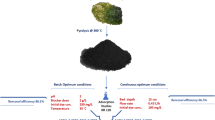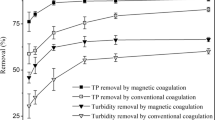Abstract
Bauxsol is a chemico-physically modified product of red mud and is a promising material for the removal and recovery of phosphorus from wastewater. In this study, response surface methodology (RSM) and artificial neural network (ANN) were employed to develop prediction models and also to investigate the interactions of independent experimental factors for phosphorus adsorption onto acid-activated Bauxsol. The experimental results indicated that HCl activation was effective to improve the adsorption capacity of Bauxsol. The maximum adsorption capacity of acid-activated Bauxsol was 55.72 mg/g (as P) with HCl concentration of 10.20 mol/L, temperature of 41.00 °C, and time of 5.60 h, which increased by 10.53 and 6.62 times compared with the raw red mud and Bauxsol before acid activation, respectively. The relative importance of HCl concentration in RSM and ANN models was 51.78 and 54.25 %, respectively, which illustrated that HCl concentration played the predominant role on improving the adsorption capacity of Bauxsol. The predictive capability of RSM and ANN models was compared, and the results showed that both models provided excellent predictions with R 2 > 0.93. However, the ANN model showed the superiority over RSM for estimation capability.




Similar content being viewed by others
References
Abdessalem, A. K., Oturan, N., Bellakhal, N., Dachraoui, M., & Oturan, M. A. (2008). Experimental design methodology applied to electro-Fenton treatment for degradation of herbicide chlortoluron. Applied Catalysis B Environmental, 78(3–4), 334–341.
Aghav, R. M., Kumar, S., & Mukherjee, S. N. (2011). Artificial neural network modeling in competitive adsorption of phenol and resorcinol from water environment using some carbonaceous adsorbents. Journal of Hazardous Materials, 188(1–3), 67–77.
Akhurst, D. J., Jones, G. B., Clark, M., & McConchie, D. (2006). Phosphate removal from aqueous solutions using neutralised bauxite refinery residues (Bauxsol™). Environmental Chemistry, 3(1), 65–74.
Alim, M. A., Lee, J. H., Akoh, C. C., Choi, M. S., Jeon, M. S., Shin, J. A., & Lee, K. T. (2008). Enzymatic transesterification of fractionated rice bran oil with conjugated linoleic acid: optimization by response surface methodology. LWT - Food Science and Technology, 41(5), 764–770.
Brunori, C., Cremisini, C., Massanisso, P., Pinto, V., & Torricelli, L. (2005). Reuse of a treated red mud bauxite waste: studies on environmental compatibility. Journal of Hazardous Materials, 117(1), 55–63.
Desai, K. M., Survase, S. A., Saudagar, P. S., Lele, S. S., & Singhal, R. S. (2008). Comparison of artificial neural network (ANN) and response surface methodology (RSM) in fermentation media optimization: case study of fermentative production of scleroglucan. Biochemical Engineering Journal, 41(3), 266–273.
Despland, L. M., Clark, M. W., Aragno, M., & Vancov, T. (2010). Minimising alkalinity and pH spikes from Portland cement-bound Bauxsol (seawater-neutralized red mud) pellets for pH circum-neutral waters. Environmental Science & Technology, 44(6), 2119–2125.
Dong, H., Guan, X., & Lo, I. M. C. (2012). Fate of As(V)-treated nano zero-valent iron: determination of arsenic desorption potential under varying environmental conditions by phosphate extraction. Water Research, 46(13), 4071–4080.
Elmolla, E. S., Chaudhuri, M., & Eltoukhy, M. M. (2010). The use of artificial neural network (ANN) for modeling of COD removal from antibiotic aqueous solution by the Fenton process. Journal of Hazardous Materials, 179(1–3), 127–134.
Ferreira, S. C., Bruns, R. E., Ferreira, H. S., Matos, G. D., David, J. M., Brandao, G. C., Silva, E. G. P., Portugal, L. A., Reis, P. S., Souza, A. S., & Santos, W. N. L. (2007). Box-Behnken design: an alternative for the optimization of analytical methods. Analytica Chimica Acta, 597(2), 179–186.
Freire, T. S. S., Clark, M. W., Comarmond, M. J., Payne, T. E., Reichelt-Brushett, A. J., & Thorogood, G. J. (2012). Electroacoustic isoelectric point determinations of bauxite refinery residues: different neutralisation techniques and minor mineral effects. Langmuir, 28(32), 11802–11811.
Genç-Fuhrman, H., Tjell, J. C., & McConchie, D. (2004a). Adsorption of arsenic from water using activated neutralized red mud. Environmental Science & Technology, 38(8), 2428–2434.
Genç-Fuhrman, H., Tjell, J. C., & McConchie, D. (2004b). Increasing the arsenate adsorption capacity of neutralized red mud (Bauxsol). Journal of Colloid and Interface Science, 271(2), 313–320.
Geyikçi, F., Kılıç, E., Çoruh, S., & Elevli, S. (2012). Modelling of lead adsorption from industrial sludge leachate on red mud by using RSM and ANN. Chemical Engineering Journal, 183, 53–59.
Guo, Y. M., Liu, Y. G., Zeng, G. M., Hu, X. J., Xu, W. H., Liu, Y. Q., Liu, S. M., Sun, H. S., Ye, J., & Huang, H. J. (2014). An integrated treatment of domestic wastewater using sequencing batch biofilm reactor combined with vertical flow constructed wetland and its artificial neural network simulation study. Ecological Engineering, 64, 18–26.
Haaland, D. P. (1989). Experimental design in biotechnology. New York: Marcel Dekker, Inc.
Huang, W., Wang, S., Zhu, Z., Li, L., Yao, X., Rudolph, V., & Haghseresht, F. (2008). Phosphate removal from wastewater using red mud. Journal of Hazardous Materials, 158(1), 35–42.
Jústiz-Smith, N., Buchanan, V. E., & Oliver, G. (2006). The potential application of red mud in the production of castings. Materials Science and Engineering A, 420(1–2), 250–253.
Kuehl, R. O. (2000). Design of experiments: statistical principles of research design and analysis (2nd ed.). Pacific Grove: Duxbury press.
Liu, C., Li, Y., Luan, Z., Chen, Z., Zhang, Z., & Jia, Z. (2007). Adsorption removal of phosphate from aqueous solution by active red mud. Journal of Environmental Sciences, 19(10), 1166–1170.
Liu, W., Yang, J., & Xiao, B. (2009). Application of Bayer red mud for iron recovery and building material production from alumosilicate residues. Journal of Hazardous Materials, 161(1), 474–478.
McConchie, D., Clark, M., & Davies-McConchie, F. (2000). Processes for water treatment. International Parent PCT/AU01/01383.
McConchie, D., Clark, M., Davies-McConchie, F., & Ryffel, T. (2002). Processes for the treatment of a waste material having a high pH and/or alkalinity. International Patent PCT/AU03/00865.
National Bureau of Statistics of China. (2014). Available at: http://data.stats.gov.cn/search/keywordlist2;jsessionid=342489F18B17DF162DF276E2B5F3729A?keyword=%E6%B0%A7%E5%8C%96%E9%93%9days.
Oguz, E. (2004). Removal of phosphate from aqueous solution with blast furnace slag. Journal of Hazardous Materials, 114(1–3), 131–137.
Singh, K. P., Basant, A., Malik, A., & Jain, G. (2009). Artificial neural network modeling of the river water quality-a case study. Ecological Modelling, 220(6), 888–895.
Sivapathasekaran, C., Mukherjee, S., Ray, A., Gupta, A., & Sen, R. (2010). Artificial neural network modeling and genetic algorithm based medium optimization for the improved production of marine biosurfactant. Bioresource Technology, 101(8), 2884–2887.
Steen, I. (1998). Management of a non-renewable resource. Phosphorus and Potassium, 217, 25–31.
Turan, N. G., Mesci, B., & Ozgonenel, O. (2011). The use of artificial neural networks (ANN) for modeling of adsorption of Cu (II) from industrial leachate by pumice. Chemical Engineering Journal, 171(3), 1091–1097.
Turan, N. G., Mesci, B., & Ozgonenel, O. (2013). Response surface modeling of Cu(II) removal from electroplating waste by adsorption: application of Box-Behnken experimental design. Clean Soil Air Water, 41(3), 304–312.
Velmurugan, R., & Muthukumar, K. (2012). Ultrasound-assisted alkaline pretreatment of sugarcane bagasse for fermentable sugar production: optimization through response surface methodology. Bioresource Technology, 112, 293–299.
Wang, S., Boyjoo, Y., Choueib, A., & Zhu, Z. H. (2005). Removal of dyes from aqueous solution using fly ash and red mud. Water Research, 39(1), 129–138.
Wang, J., Song, Y., Yuan, P., Peng, J., & Fan, M. (2006). Modeling the crystallization of magnesium ammonium phosphate for phosphorus recovery. Chemosphere, 65(7), 1182–1187.
Wang, S., Ang, H. M., & Tadé, M. O. (2008). Novel applications of red mud as coagulant, adsorbent and catalyst for environmentally benign processes. Chemosphere, 72(11), 1621–1635.
Wei, L., Qiu, H., Zhang, J., Yu, Y., Yang, K., Liu, Z., & Ding, G. (2009). Characteristic of a novel composite inorganic polymer coagulant-PFAC prepared by hydrochloric pickle liquor. Journal of Hazardous Materials, 162(1), 174–179.
Weng, L., Vega, F. A., & Riemsdijk, W. H. V. (2011). Competitive and synergistic effects in pH dependent phosphate adsorption in soils: LCD modeling. Environmental Science & Technology, 45(19), 8420–8428.
Witek-Krowiak, A., Chojnacka, K., Podstawczyk, D., Dawiec, A., & Pokomeda, K. (2014). Application of response surface methodology and artificial neural network methods in modelling and optimization of biosorption process. Bioresource Technology. doi:10.1016/j.biortech.2014.01.021.
Zarei, M., Niaei, A., Salari, D., & Khataee, A. (2010). Application of response surface methodology for optimization of peroxi-coagulation of textile dye solution using carbon nanotube–PTFE cathode. Journal of Hazardous Materials, 173(1–3), 544–551.
Zhang, Y. N., & Pan, Z. H. (2005). Characterization of red mud thermally treated at different temperatures. Journal of Jinan University (Science and Technology), 19, 35–38.
Zhang, S., Liu, C., Luan, Z., Peng, X., Ren, H., & Wang, J. (2008). Arsenate removal from aqueous solutions using modified red mud. Journal of Hazardous Materials, 152(2), 486–492.
Zhang, T., Ding, L., Ren, H., Guo, Z., & Tan, J. (2010). Thermodynamic modeling of ferric phosphate precipitation for phosphorus removal and recovery from wastewater. Journal of Hazardous Materials, 176(1–3), 444–450.
Zhao, Y., Zhang, L., Ni, F., Xi, B., Xia, X., Peng, X., & Luan, Z. (2011). Evaluation of a novel composite inorganic coagulant prepared by red mud for phosphate removal. Desalination, 273(2–3), 414–420.
Zinatizadeh, A. A. L., Mohamed, A. R., Abdullah, A. Z., Mashitah, M. D., Isa, H. M., & Najafpour, G. D. (2006). Process modeling and analysis of palm oil mill effluent treatment in an up-flow anaerobic sludge fixed film bioreactor using response surface methodology (RSM). Water Research, 40(17), 3193–3208.
Acknowledgments
The authors are thankful to the China Scholarship Council (CSC), the National Natural Science Foundation of China (51178047, 51378190, 51039001), and Furong Scholar of Hunan Province for supporting.
Author information
Authors and Affiliations
Corresponding authors
Rights and permissions
About this article
Cite this article
Ye, J., Zhang, P., Hoffmann, E. et al. Comparison of Response Surface Methodology and Artificial Neural Network in Optimization and Prediction of Acid Activation of Bauxsol for Phosphorus Adsorption. Water Air Soil Pollut 225, 2225 (2014). https://doi.org/10.1007/s11270-014-2225-1
Received:
Accepted:
Published:
DOI: https://doi.org/10.1007/s11270-014-2225-1




